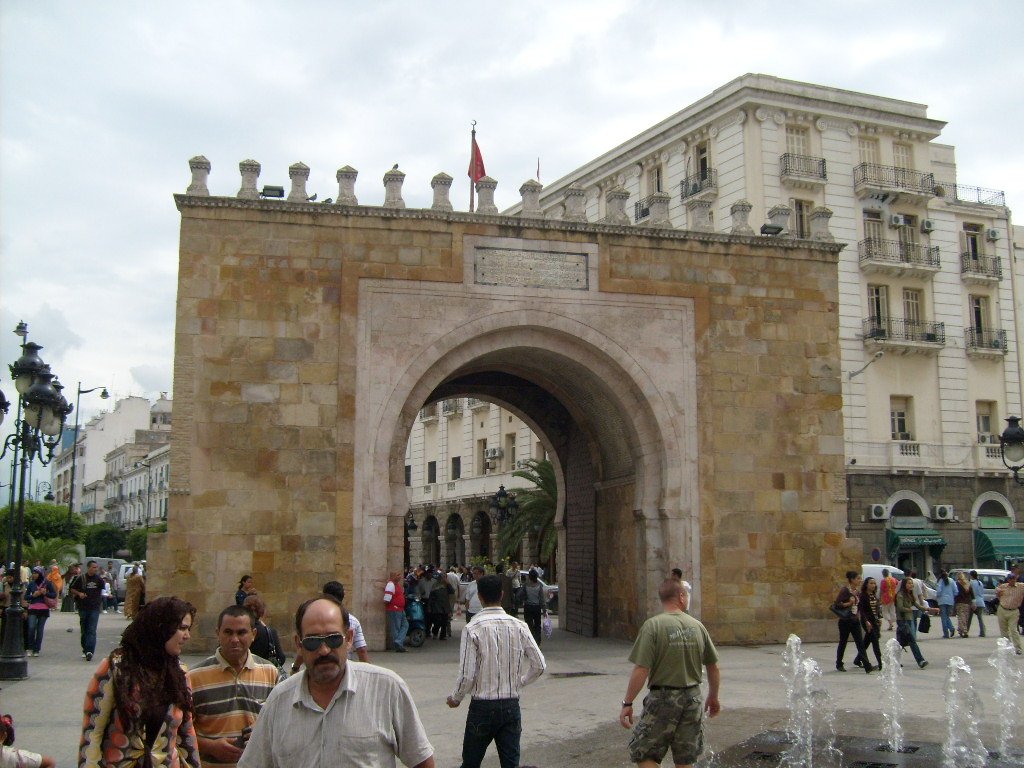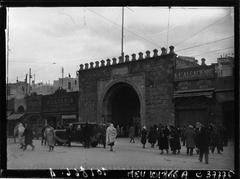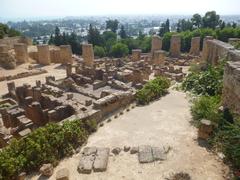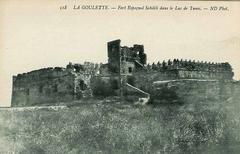
Bab El Bhar Visiting Guide: Hours, Tickets, and Historical Insights
Publication Date: 18/08/2024
Introduction to Bab El Bhar
Bab El Bhar—meaning “Sea Gate” or “Porte de France”—is one of the most prominent historical landmarks in the heart of Tunis, Tunisia’s bustling capital. Serving as the main gateway to the Medina of Tunis, a UNESCO World Heritage Site, Bab El Bhar is renowned for its distinctive architectural features and its pivotal role in the city’s history. Erected in the 13th century under the Hafsid dynasty, the gate has evolved in design and function over the centuries, absorbing influences from Islamic, Mediterranean, and later Ottoman styles. Its iconic horseshoe arch and crenellated parapets, introduced during the Ottoman period, remain a testament to the city’s layered architectural heritage (Wikipedia).
Once a defensive fortification and customs checkpoint, Bab El Bhar has transitioned into a powerful cultural symbol. Its proximity to the port of Tunis made it integral to the city’s commercial life, and today, it welcomes both locals and travelers eager to explore the vibrant Medina. This guide provides a detailed exploration of Bab El Bhar, including its historical context, architectural evolution, visiting information, and key attractions nearby.
Exploring Bab El Bhar: Visiting Hours, History, and Travel Tips
Historical Overview
Origins and Construction
Bab El Bhar was originally constructed in the 13th century during the reign of the Hafsid dynasty, which governed the region for several centuries. The Hafsids contributed significantly to the architectural and urban development of Tunis, with Bab El Bhar standing as a landmark of their era.
Architectural Evolution
Initially a modest archway, Bab El Bhar was later fortified to strengthen the city’s defenses. The 18th-century Ottoman influence introduced the horseshoe arch and battlements that define its silhouette today. This blend of Islamic and Mediterranean motifs makes the gate an architectural highlight in Tunis.
Strategic and Cultural Importance
Historically, Bab El Bhar served as a major entry point to the Medina, controlling access to the bustling souks and residential quarters. Its location near the port underscored its role in trade, customs, and city defense. As the city expanded, Bab El Bhar became a symbolic threshold between old Tunis and the modern European quarters that emerged during the colonial period. Over the centuries, it has witnessed invasions, shifts in power, and vibrant commercial exchange.
Bab El Bhar’s Role in Trade and Urban Life
During the medieval period, Bab El Bhar was central to the city’s commerce. The Medina, accessible through the gate, was a thriving hub where merchants traded spices, textiles, and precious goods from across the Mediterranean. The gate functioned both as a customs post and as a guardian of the city’s economic and social life.
Cultural Impact
Beyond its practical functions, Bab El Bhar has inspired generations of artists, writers, and historians. The gate features prominently in Tunisian art and folklore as a symbol of resilience and continuity. Its name, “Sea Gate,” reflects the city’s deep-rooted connections to the Mediterranean, which has shaped Tunisian identity through centuries of trade and cultural exchange.
Visitor Information
Visiting Hours and Ticket Information
Bab El Bhar is a public monument and can be visited at any time. While the gate itself is open 24/7, it is best experienced during daylight hours for safety and optimal viewing. There is no entrance fee to visit the gate. Guided walking tours that include historical commentary and visits to surrounding attractions are available for a fee through local tour operators (GPSmyCity).
Accessibility and Tips for Visitors
- Getting There: Bab El Bhar is situated at Place de la Victoire, at the entrance to the Medina. It is easily reached by bus, taxi, or on foot from central Tunis. The Tunis Marine train station is nearby, connecting to other parts of the city.
- When to Visit: The best times are early morning or late afternoon to avoid crowds and midday heat. Spring and autumn offer the most pleasant weather.
- What to Wear: Comfortable shoes are recommended due to cobblestone streets. Modest dress is advisable out of respect for local customs.
- Accessibility: The area is pedestrian-friendly but may pose challenges for visitors with limited mobility due to uneven surfaces.
- Safety: The Medina is generally safe, but remain vigilant for pickpockets in crowded areas and keep valuables secure.
- Photography: The gate is a favorite among photographers, particularly during the golden hours of early morning and late afternoon. Always ask permission before photographing people.
Nearby Attractions
Bab El Bhar is ideally located for exploring the rich tapestry of Tunis’s historical and cultural sites. Notable attractions within walking distance include:
- Medina of Tunis: A maze of narrow alleys, traditional souks, and historic buildings, recognized as a UNESCO World Heritage Site (Wikipedia).
- Zitouna Mosque: Founded in 734 AD, this is Tunisia’s principal mosque and an important center of Islamic learning (Lonely Planet).
- Souq des Chechias: A vibrant market specializing in the traditional Tunisian felt hat, the chechia (Lonely Planet).
- Marché Centrale: A bustling central market known for its fresh produce, spices, and Tunisian delicacies (Lonely Planet).
- Cathedral of St Vincent de Paul & St Olive: An impressive 19th-century cathedral blending Moorish, Gothic, and Neo-Byzantine architectural styles (Lonely Planet).
- Madrasa El Bachia and Madrasa Slimania: Historical Quranic schools reflecting the educational legacy of the city (Lonely Planet).
- Dar Othman: A 16th-century palace showcasing rich period architecture (Lonely Planet).
- Bardo Museum: Home to one of the world’s greatest collections of Roman mosaics (Lonely Planet).
- Uthina and Antonine Baths: Ancient Roman sites located a short drive from the city, offering insight into Tunisia’s classical past (Lonely Planet).
Preservation Efforts
In recent decades, Bab El Bhar has benefitted from conservation projects led by the Tunisian government and organizations such as UNESCO. These initiatives focus on structural restoration, historical accuracy, and the preservation of the gate’s unique architectural features, ensuring that Bab El Bhar remains accessible and meaningful for future generations (Digital Public Library of America).
Frequently Asked Questions
-
What are the visiting hours for Bab El Bhar?
Bab El Bhar is accessible 24/7, but daylight hours are recommended for optimal safety and visibility. -
Is there an entrance fee?
No, Bab El Bhar is a public monument and does not require an entrance fee. -
Are guided tours available?
Yes, several local operators offer guided walking tours of the Medina that include Bab El Bhar as a highlight (GPSmyCity). -
Is the area wheelchair accessible?
The area is pedestrian-friendly but features cobblestone streets, which may present challenges for those with limited mobility. -
What are the top nearby attractions?
Key sites include the Medina of Tunis, Zitouna Mosque, Marché Centrale, and the Bardo Museum.
Summary
Bab El Bhar stands as a timeless symbol of Tunis’s historical and cultural legacy. From its origins as a fortified gateway to its current status as a cherished landmark, the gate embodies the city’s resilience and rich heritage. Easily accessible, steeped in history, and surrounded by vibrant attractions, Bab El Bhar is a must-see for anyone visiting Tunis. Ongoing preservation efforts ensure that this iconic monument will continue to inspire and educate for generations to come.
For more information and self-guided tours, consider using the GPSmyCity app, which offers offline maps and detailed walking guides.
Sources and Further Reading
- Medina of Tunis, Wikipedia
- Bab El Bhar (Gate of France), GPSmyCity
- Bab El Bhar, Digital Public Library of America



